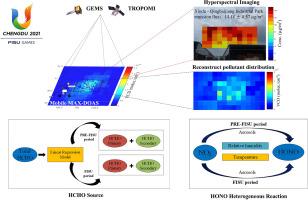2023年成都FISU世界大学生运动会期间NO2、HCHO和HONO的移动MAX-DOAS测量及来源分析
IF 6.3
2区 环境科学与生态学
Q1 ENVIRONMENTAL SCIENCES
引用次数: 0
摘要
为了在第31届世界大学生运动会期间保持空气质量,成都在2023年采取了一系列监测和控制策略。通过将移动MAX-DOAS测量的垂直柱密度(vcd)与高斯过程回归分析相结合,重建了高分辨率区域污染物分布。MAX-DOAS与GEMS和TROPOMI卫星数据的空间分布相关性超过0.6。本文探讨了奥运会期间空气质量改善对HCHO来源和HONO形成过程的影响。在控制期内,一次排放和二次生成的HCHO对大气总HCHO的贡献率分别为50.85%±24.24%和42.81%±7.57%。研究表明,随着空气质量的改善,HCHO一次排放减少,二次排放和大气辐射透射强度增加。发现HONO总是在气溶胶光学深度(AOD)和NO2高的条件下出现,但NO2浓度和AOD高并不一定伴随着高浓度的HONO。为了评估温度和湿度对NO2形成HONO的影响,我们计算了排放率ΔHONO/ΔNO2,以量化一次源对HONO总浓度的影响。分析结果表明,相对湿度的拐点为65%(60% ~ 70%),温度的拐点为31℃(30 ~ 32℃)。研究发现,较低的温度和较高的湿度水平会降低NO2生成次生HONO的速率。本文章由计算机程序翻译,如有差异,请以英文原文为准。

Mobile MAX-DOAS measurements and source analysis of NO2, HCHO, and HONO during the Chengdu 2023 FISU world university games
To maintain air quality during the 31st World University Games, Chengdu employed a range of monitoring and control strategies in 2023. High-resolution regional pollutant distributions were reconstructed by integrating the vertical column densities (VCDs) from mobile MAX-DOAS measurements with Gaussian process regression analysis. The correlation between the spatial distribution derived from MAX-DOAS and that of GEMS and TROPOMI satellite data exceeded 0.6. This paper explores the impact of air quality improvements during the games on the sources of HCHO and the formation process of HONO. During the control period, primary emissions and secondary formations of HCHO contributed 50.85 % ± 24.24 % and 42.81 % ± 7.57 % to the total atmospheric HCHO, respectively. The study indicates that with improved air quality, HCHO primary emissions decrease while secondary emissions and atmospheric radiation transmission intensities rise. It is found that HONO always appears under the condition of high aerosol optical depth (AOD) and NO2, but high NO2 concentration and AOD are not necessarily accompanied by high concentrations of HONO. To assess the influence of temperature and humidity on the formation of HONO from NO2, we calculated the emission rates to quantify the impact of primary sources on total HONO concentrations. The analysis results show that the turning point of relative humidity is 65 % (60 %–70 %) and the turning point of temperature is 31 °C (30–32 °C). Lower temperatures and higher humidity levels were found to decrease the rate of secondary HONO formation from NO2.
求助全文
通过发布文献求助,成功后即可免费获取论文全文。
去求助
来源期刊

Journal of Environmental Sciences-china
环境科学-环境科学
CiteScore
13.70
自引率
0.00%
发文量
6354
审稿时长
2.6 months
期刊介绍:
The Journal of Environmental Sciences is an international journal started in 1989. The journal is devoted to publish original, peer-reviewed research papers on main aspects of environmental sciences, such as environmental chemistry, environmental biology, ecology, geosciences and environmental physics. Appropriate subjects include basic and applied research on atmospheric, terrestrial and aquatic environments, pollution control and abatement technology, conservation of natural resources, environmental health and toxicology. Announcements of international environmental science meetings and other recent information are also included.
 求助内容:
求助内容: 应助结果提醒方式:
应助结果提醒方式:


